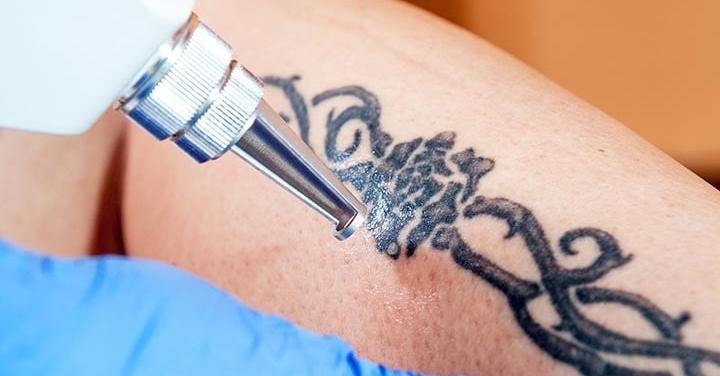Laser tattoo removal has become one of the most popular methods for getting rid of unwanted tattoos. It offers a safe and effective way to remove tattoos of all colors and sizes, without the need for invasive surgical procedures. If you are considering laser tattoo removal, this comprehensive guide will provide you with all the information you need to know before and after tattoo removal.
How Does Laser Tattoo Removal Work?
Laser tattoo removal works by targeting the tattoo ink with high-intensity laser beams. The laser energy is absorbed by the tattoo pigment, which causes it to break down into smaller particles. These tiny particles can then be naturally eliminated by the body’s immune system over time.
Different laser wavelengths are used to target specific ink colors. For example, a Q-switched Nd:YAG laser is commonly used for dark-colored inks, while a ruby laser is effective for lighter colors. A trained professional will determine the most appropriate laser system for your tattoo during the consultation process.
The Process of Laser Tattoo Removal
Laser tattoo removal is typically performed in a series of sessions. The number of sessions required depends on various factors, including the tattoo size, tattoo colors, ink composition, and your skin’s response to the treatment.
During the procedure, the laser is passed over the tattooed area in short bursts. You may experience some discomfort during the treatment, which is often compared to the sensation of a rubber band being snapped against the skin. However, many clinics offer numbing creams or local anesthesia to minimize any discomfort.
After each treatment session, you will likely experience some redness, swelling, and temporary blistering. These are normal side effects and indicate that the body is responding to the laser treatment. Your tattoo will gradually fade as your body eliminates the fragmented ink particles.
Factors Affecting the Success of Laser Tattoo Removal
While laser tattoo removal is generally effective, several factors can affect its success rate:
1. Tattoo Color and Pigment Type
Dark-colored inks, such as black and blue, are highly receptive to laser treatments and usually respond well. Lighter colors, such as green, yellow, and pastels, can be more challenging to remove and may require additional sessions. However, advancements in laser technology have made it possible to treat a wide range of colors effectively.
2. Ink Depth and Skin Type
The depth at which the ink was placed in your skin, as well as your skin type, can also influence the success of laser tattoo removal. Superficially placed tattoos are generally easier to remove than those implanted deeper into the skin. Additionally, individuals with fair skin tend to have better results, as the laser’s energy can more easily target the tattoo pigment without affecting the surrounding skin.
3. Tattoo Age and Quality
Older tattoos are generally easier to remove than newer ones. Over time, the tattoo ink breaks down, making it more responsive to the laser treatment. Additionally, tattoos created by professional artists using high-quality ink tend to respond better to laser removal compared to amateur tattoos.
4. Immune System and Overall Health
The body’s immune system plays a significant role in removing the fragmented tattoo ink particles. A healthy immune system can more efficiently eliminate the ink, resulting in faster and more effective removal. Individuals with compromised immune systems or certain health conditions may experience a slower response to treatment.
Benefits and Risks of Laser Tattoo Removal
Laser tattoo removal offers several benefits compared to other tattoo removal methods:
1. Non-Invasive
Laser tattoo removal is a non-invasive procedure that does not require any surgical incisions. It offers a safe alternative to surgical excision, which can result in scarring and longer recovery times.
2. Versatility
Laser technology has advanced significantly, allowing for the removal of tattoos of all colors and sizes. From small, simple designs to large, complex tattoos, laser tattoo removal can treat a wide range of tattoos.
3. Minimal Downtime
After each treatment session, you may experience some redness and temporary side effects, but the downtime is minimal. Most people can resume their daily activities immediately after treatment.
It is important to note that while laser tattoo removal is generally safe and effective, there are some risks and potential side effects, including:
- Hyperpigmentation or hypopigmentation (darkening or lightening of the skin)
- Temporary or permanent scarring
- Infection, although rare if proper aftercare instructions are followed
- Allergic reactions to the laser or numbing creams (rare)
The Importance of Choosing a Qualified Professional
To ensure a safe and effective laser tattoo removal treatment, it is crucial to choose a qualified professional with experience in tattoo removal. A skilled technician or dermatologist will assess your tattoo and skin type, create a personalized treatment plan, and adjust the laser settings for optimal results.
Additionally, they will provide you with proper aftercare instructions and closely monitor your progress throughout the treatment process.
Conclusion
Laser tattoo removal is a safe and effective way to rid yourself of unwanted tattoos. The treatment works by targeting the tattoo ink with laser energy, causing it to break down and fade over time. While the success of laser tattoo removal depends on several factors, advancements in laser technology have made it possible to remove tattoos of all colors and sizes.
If you’re considering laser tattoo removal, it’s essential to consult with a qualified professional who can assess your tattoo and guide you through the process. With proper care and multiple treatment sessions, you can gradually fade and eventually eliminate your unwanted tattoo, allowing you to move forward with a fresh start.
